How To Clean Your Basketball
Power Clean Form 101: Perfect Your Form and Build Power
The Power Clean is an explosive full-body exercise that can help any athlete in any sport–if it's performed correctly. But this exercise—like all Olympic lifts—is very technical and needs to be executed with precision to achieve maximum benefits while reducing your chance of injury.
Ideally, you want to learn how to Power Clean under the guidance of a certified strength and conditioning coach. But that's not always possible, so in this article (and video above), Cleveland-based strength coach Mike Anderson provides a step-by-step photo guide on how to perform the move.
First, we'll talk about why you should perform the Power Clean. We'll then show you how to execute the move itself. Lastly, you'll find a guide to exercises and drills that will help you learn the move if you're new to it.
Benefits of the Power Clean
The Power Clean—and other Olympic Lifts—will make you a more powerful and explosive athlete, essential for those who depend on explosiveness to effectively block linemen, out-jump opponents for a rebound, or crush a serve in volleyball (just to name a few activities).
The Power Clean trains "triple extension"—your ankles, knees and hip joints must extend simultaneously—which is a key movement for athletic performance. The exercise also recruits fast-twitch muscle fibers, which generate the greatest force and speed. And athletes who need to jump are especially well-served by learning the move, which has been shown to improve vertical jump more effectively than traditional powerlifting moves like the Squat.
What muscles are involved? Literally all of them. Just look at the activation chart above. Your core, quads, hamstrings, calves and glutes are the driving forces behind most of the movement, but your traps and shoulders are engaged during the second pull. And that's to say nothing of the muscles in your arms, forearms and back, which also get involved. Simply put: this exercise works the entire body.
Power Clean Technique: A Step-by-Step Guide
Step 1: Setup
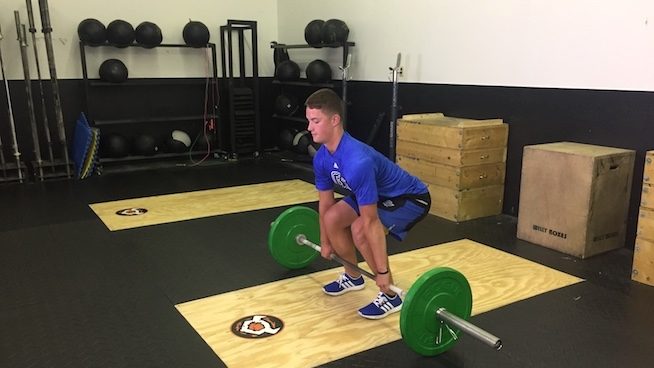
Begin with the bar on the floor positioned close to your shins over your shoelaces. Stand with your feet hip-width apart, reach down and grab the bar with an overhand, shoulder-width grip.
Sit your butt down and stick your chest up. Pull your shoulder blades down and back and tighten your core. Your elbows should be rotated out to the sides with your arms completely straight. Look straight ahead.
Step 2: First Pull
Pull the bar off the floor by powerfully extending your legs, making sure to keep your back flat and your chest up. The bar should travel vertically in a straight line, not into you like during a Deadlift.
Step 3: Scoop and Second Pull
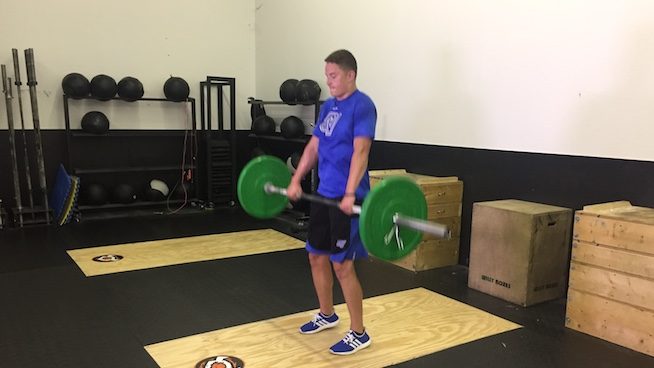
Once the bar is above your knees, shift your torso to a vertical position and rebend your knees slightly. This is the scoop.
Now initiate the second pull—the most powerful portion of the movement—by violently jumping straight up, fully extending your hips, knees and ankles (triple extension), while simultaneously shrugging the bar with your shoulders. Keep the bar as close to your body as possible.
Step 4: Catch
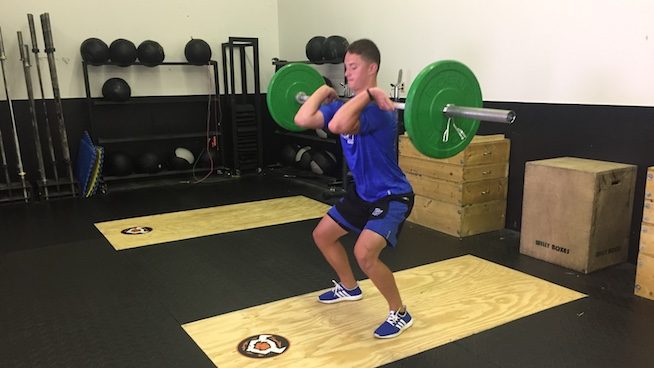
Quickly drop into a quarter-squat position with your back straight, and hips and knees slightly bent. Drive your elbows forward to rotate them around in the bar and catch the bar in the racked position across the front of your shoulders with your fingertips under the bar. Now stand up.
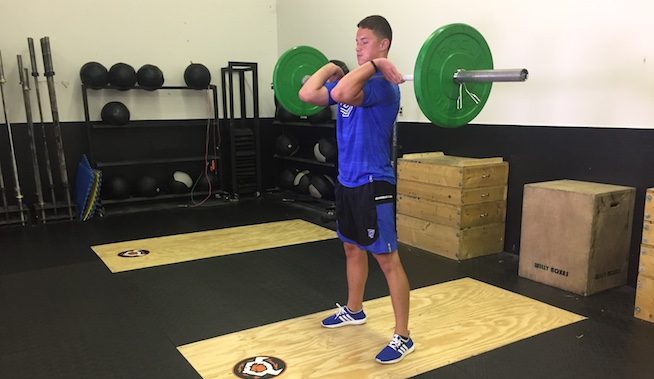
Step 5: Drop the bar
From this position, drop the bar to the ground in front of you, but only do this if you're using bumper plates and ideally you're on a lifting platform. If you're using a light weight, you can lower it to the ground as shown in the video above.
Remember: The Power Clean Is Not a Hang Clean
In the Power Clean, you always start the lift with the weight on the floor. The Hang Clean starts with the weight held above the knee.
Power Cleans Are Usually Best Performed Light
Because the Power Clean is complex, it's a move that should be practiced often. But that doesn't mean you should overdo it in terms of weight. In fact, your workouts should almost always be performed with manageable weights—think 60 to 85% of your max.
More important than load is your speed of movement. You want to achieve maximum velocity on every rep. So it's a good practice to keep your rep range limited to 1-5 reps per set. Perform each with as much speed and intensity as you can.
Yes, you can max out—occasionally. But most of the time your goal is to take a reasonable weight and let 'er ripfast, and with clean form.
Common Power Clean Form Mistakes
Landing with your feet too wide
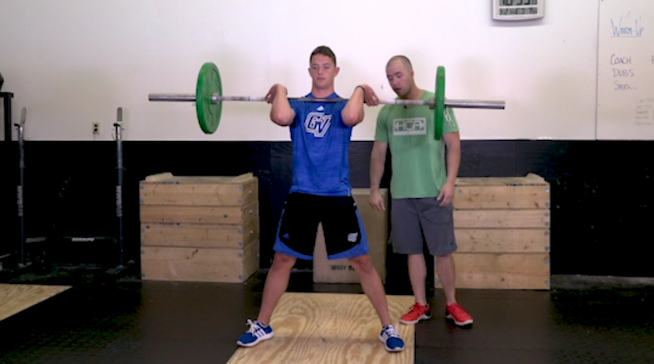
Anderson explains that landing with your feet too wide—a common mistake—limits your hip mobility and makes it more difficult to properly drop under the bar. The fix is simple. Land with your feet in the same position you'd use for a Front Squat. If you have trouble perfecting this technique, check out Anderson's drills here.
Not engaging your back and core before a rep
It's crucial that your back is not rounded during this lift. Engage your back and bring your shoulder blades down and back and tighten your core as if you're about to take a punch. This ensures that your back and core are set and reduces your risk of injury.
Muscling up the weight
You want to launch the barbell by forcefully extending your hips. Practice extending the hips while keeping the barbell close to your body. To learn this movement pattern, try the Hang Jump Shrugs demonstrated by STACK Contributor Miguel Aragoncillo in this video:
Catching the bar with your arms
One of the most common mistakes newbie athletes make is catching the bar with their forearms almost vertical. This automatically limits that amount of weight you can lift, adds stress to your joints and makes each rep more taxing than it already is. Practice snapping your elbows through and catching the bar across your shoulders with an unloaded bar or broomstick before adding weight.
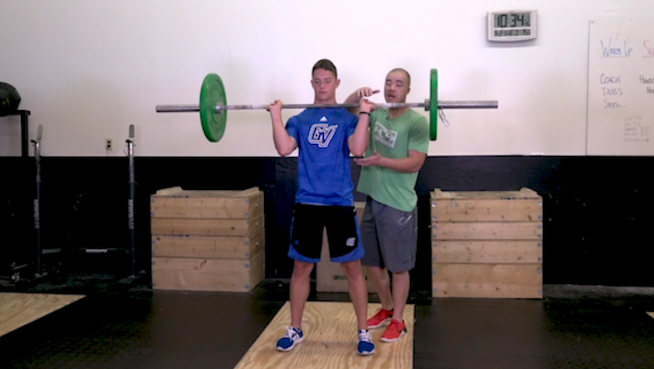
Performing too many repetitions—or performing them too quickly in a row
Power Cleans are not for conditioning. They are meant to train your body to apply as much force as quickly as possible. So the maximum number of reps you should do in a set is 5 or so. If you go beyond that, you'll fatigue and compromise your power output and/or technique, and then you're defeating the whole purpose here. For this same reason, it's important to pause briefly between reps to reset, refocus and execute the next rep to the best of your ability.
However, there's no hiding the fact that the exercise has become an extremely popular conditioning exercise. That's OK as long as you use a light weight and maintain your form. There's no shame in taking a rest if you sense that your form is beginning to break down, considering faulty technique can lead to injury.
Lastly, it's worth noting that while the Power Clean is a great exercise with powerful benefits, not everyone should do it. alternatives that deliver a lot of the same benefits.
READ MORE:
- Supplemental Lifts to Help You Build a Strong Clean
- Hang Clean Technique Drills
- These LSU Football Players Cleaning 594-Pounds is a Must-Watch
Comments are closed.
Share This Story!
RECOMMEN DED FOR YOU
MOST POPULAR
How To Clean Your Basketball
Source: https://www.stack.com/a/power-clean/
Posted by: pylantthereave.blogspot.com

[…] of metal. I turned to high-five Anthony, overcome by a strange, primal joy. After four sets of power cleans and deadlifts, I should have been exhausted, but my body thrummed with adrenaline. It was the most […]